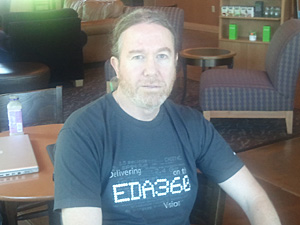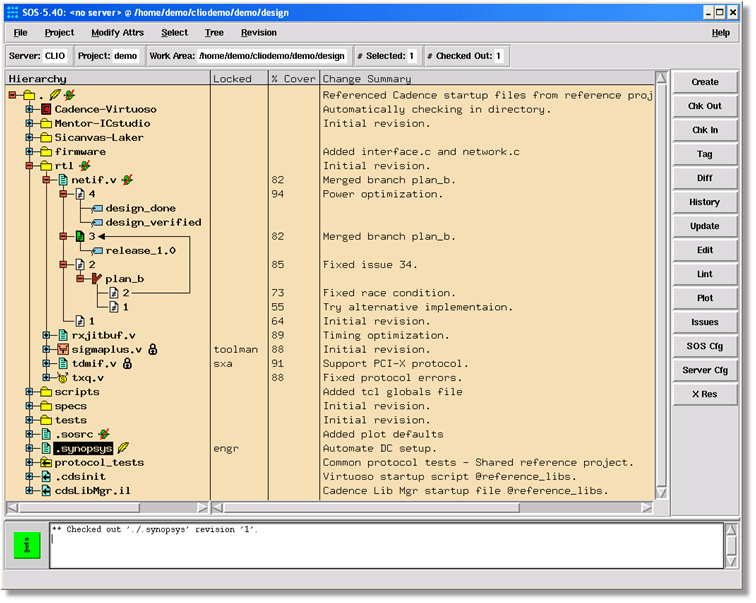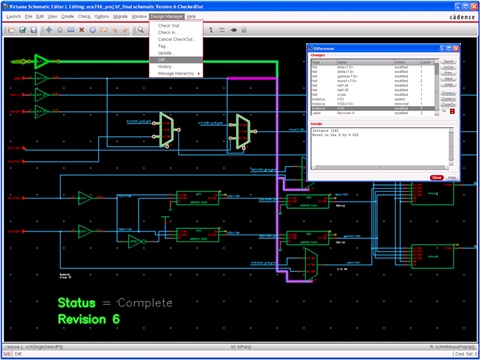Last Monday I sat down with Grego Sanguinetti in Beaverton, Oregon at the campus of Tektronix to hear about how they design their ICs using EDA tools from multiple vendors.



Q: When did you join Tek?
A: – I joined in 1982, left, did start ups (Micron – embedded DRAM design) then returned in 2003.
Q: What types of designs are done here?
A: uwave to big mixed-signal SOCs, variety of process: SiGe, CMOS, GaAs, InP
Q: What IC design tools do you use?
A: We have Cadence Virtuoso for the IC flow.
Q: How do you manage the IC design data and teams?
A: We’ve been using SOS from ClioSoft.

Q: Which projects have used ClioSoft HCM (Hardware Configuration Management) tools?
A: Quite a variety: Preamplifiers, dmuxes, T&M data acquisition chips, TDR equipment.
Q: Have you tried any other techniques for HCM before ClioSoft?
A: Yes, we have tried: source code revision (RCCS, VCS, custom code to checkin views in Cadence with RCCS).
Q: Why didn’t you use any of those tools for IC designs?
A: Those approaches are just version control of text-based files, like Verilog trees, but they aren’t designed for IC layout databases like Virtuoso. Clearcase was used for SW developers, and we evaluated using that within Cadence tools. Synchronicity tools were used at Micron, and then I did some evaluation at Tek with Synchronicity, but eventually decided on Cliosoft instead.
Q: What were your choices for HCM when you rejoined Tek in 2003?
A: Our choices were: internal tools, Clearcase, ClioSoft andSynchronicity.
Q: What was the main reason that you opted for SOS from ClioSoft?
A: SOS is easiest to use inside of Cadence Virtuoso.
Q: Have you always used Cadence IC tools at Tek?
A: No, we had been using Internal Tools – SPICE, schematics, simulation interface. We then moved to Cadence Virtuoso with ClioSoft tools.
Q: What are the tangible benefits of using an HCM like ClioSoft?
A: I can really keep track of what is going on and who is working on each part of a chip design. As an example we were building a PDK for a process that needed to be heavily modified and had about 25 people on this project and a new chip (A2D converter) using the PDK while it was being developed, so using configuration management helped:
- Who is editing what
- No clobbering of data
- Can go back in time
- Create branches for exploration
- Merge branches
- Tagging all the files as a snapshot
- Easy to setup what an end user would see in their files
- Good to organize information
Q: How do you feel about using EDA tools with a GUI in general?
A: I’m kind of against using graphical tools to organize and prefer instead to using Text and typing with shell scripts.
Q: What can you tell me about SOS and the GUI?
A: It’s actually well organized, easy to use, quick in operation. Shell commands can also be used with the GUI too, so that’s a plus.
Q: What is the learning curve for HCM in your experience?
A: Training took just a few minutes to train each of the 25 users of SOS. If they know the concept of Check in and Check out then their start up time is minutes. So intuitive to learn and use.
Q: What was your experience with learning other HCM tools?
A: Not so easy with Synchronicity or Clearcase (3 volume user manual).
Q: How have you made SOS easy for new users?
A: We’ve done some customization – scripts used to help setup a new project, user workspace, all automated. The scripts are written in Perl.
Q: How would a user of Virtuoso use HCM in their typical flow?
A: Users within the GUI would just right-click over a cell and then choose Checkin or Checkout.
Q: Were you the first ClioSoft user at Tek?
A: No, I took over the responsibility for ClioSoft tools, did upgrades and handled Cadence transitions, only had to make a few phone calls to get help, never stumped on the tech support lines. They can monitor my screen to see what I’m doing, find the issue, tell me how to update. ClioSoft has offered me the best EDA support that I’ve seen in 30 years.
Q: Are there any issues between Cadence and ClioSoft tools?
A: With our Cadence upgrades we’ve had no real glitches with ClioSoft tools. Tek was an early user of OA (on the OA committee, Si2 group). Some brokenness in Cadence tools during OA transition using symbolic file links (library browsing). SOS on OA didn’t work because of path name implementation. Cadence in the early days of OA took the bug report about Lib.def. Integration of SOS with Cadence changed as OA became more widely used.
Q: Any issues with bugs in SOS?
A: Not really, it’s just a very solid tool.
Q: How did you work with the remote design team in Santa Clara?
A: For our Santa Clara site the setup of SOS was done remotely. I trained new users over the phone (about half had already used it before). That office has a dozen or so engineers using SOS tools.
Q: What about using HCM across time zones?
A: In India we have engineers using SOS tools also, about a dozen to two dozen. Remote synch works great, never any issues (expected to see some issues – Synchronicity had issues to setup remotely. Took much time.) Setup was trivial with SOS. Synch load – quite light between sites, not much stress seen.
Q: What is new in SOS these days?
A: New SOS feature likes – Just added Visual Diff tools, what a great help. Need to upgrade licenses to use that feature, standard in the Enterprise Edition. Design reuse – we see benefit in being able to dynamically reuse parts of a design, even if it’s not finished yet.

Q: Why should an IC team consider using HCM tools from ClioSoft?
A: The main reasons are: stable tool, trivial to use, easy to support (don’t need a CAD group), learning is simple.
Q: Does Tek have dedicated CAD people?
A: No, we mix both CAD and design tasks in our engineers, so we have no dedicated CAD people.
Summary
Cadence Virtuoso IC design teams can effectively manage their multi-site teams using Hardware Configuration Management (HCM) tools from ClioSoft. Tek has successfully used SOS with Virtuoso tools in a variety of IC design projects.
Also Read
Richard Goering does Q&A with ClioSoft CEO
Hardware Configuration Management at DAC
Cadence Virtuoso 6.1.5 and ClioSoft Hardware Configuration Management – Webinar Review
Share this post via:






Comments
There are no comments yet.
You must register or log in to view/post comments.